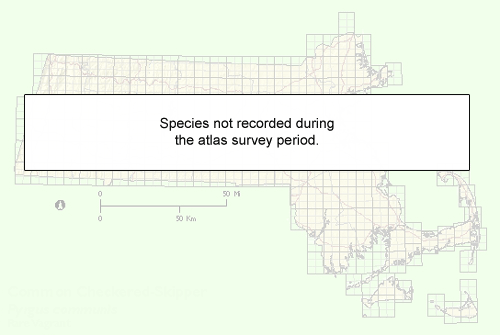Find a Butterfly
Columbine Duskywing
Erynnis lucilius
Named
Scudder and Burgess, 1870
Identification
Wingspan: 7/8 - 1 1/4". Very similar to Wild Indigo and Persius Dusky Wings with females of these species impossible to separate reliably. Even male genitalia in Columbine and Wild Indigo are too similar to be of any use in identification. The best characters to be looked for in fresh males are: (1) Forewings above more uniform brown, less contrasting than the other species; lacking the reddish brown spot near the end of the discal cell that is typical of baptisiae; and (2) Nearly lacking the white, flattened, hair-like scales on the forewing that can be seen with a hand lens on the other species. Lucilius is on average smaller than baptisiae. In practice, habitat and status may be the best way to separate these species. Persius is now extremely rare and can generally be eliminated from consideration unless the habitat seems ideal. Lucilius typically flies in or near rocky woods where its foodplant, Wild Columbine, thrives; the other two species prefer barrens and disturbed open areas where Wild Indigo or lupine are common.
Distribution
Southern fringes of Canada from western Ontario to eastern Quebec east through the Great Lakes states to New Hampshire, south to southern Ohio, central Pennsylvania and northern New Jersey and south through the Appalachians to Kentucky. In New England it has been reliably recorded from southern New Hampshire (Durham: "Weed and Fiske materials" fide Borror, 1974) and it continues to survive in Connecticut.
Status in Massachusetts
Occurred historically, but now possibly extirpated. Scudder seems to have distinguished this species clearly from persius/baptisiae and to have considered it uncommon but by no means rare in appropriate habitat. The old specimens in the MCZ (and elsewhere) from localities such as South Hadley, North Leverett, Mt. Toby, Montague, Deerfield, and Granby are probably correctly labeled as this species. Specimens from Waltham, Malden and Milton also appear to be lucilius, but have not been carefully checked for wing hairs. The species was not found during the Atlas project (1986-90) despite a concerted effort by Leahy and Sorrie to check the most promising columbine localities in the state when this duskywing would be flying, and Schweitzer failed to find it despite serious attempts in Franklin and Hampshire counties in the 1970s. However, it is not implausible that the species hangs on here in small populations in the Holyoke range and other localities where the foodplant is abundant.

Flight Period in Massachusetts
Apparently the same as that of Wild Indigo Dusky Wing (early May through August, peaking mid-July to mid-August) but perhaps flying more often into September. Usually cited as triple brooded, and certainly at least double brooded in New England.
Larval Food Plants
Species of columbine only. The native foodplant is Wild Columbine (Aquilegia canadensis).
Adult Food sources
Not reported in Massachusetts.
Habitat
Rocky woods in association with the foodplant, but it can turn up in any situation where columbine is well distributed over a sizeable area. For example, females will oviposit on garden columbines.
Life Cycle
EGG: Pale whitish green at first, turning "pale salmon color" with age (Scudder, 1889); a hemispherical dome with 12-15 prominent vertical ribs with fine, raised lateral lines running between and densely covered with tiny punctures. OVIPOSITION: Eggs laid singly, almost invariably on the underside of the tenderest leaves of the food plant; hatching in June about 10 days after laying. LARVA: Stout and tapering to both ends. Green (Scudder says that it is slightly paler than columbine leaves!) with a darker green stripe down the back and a pale yellow line along the sides; densely covered with tiny white or yellowish "wartlets" or "granules" with a short white hair arising from each. The prominent head is black variably marked with streaks and spots of reddish brown. CHRYSALIS: Pale green, wings and thorax slightly darker; thickly covered in fine hairs. PUPAL STAGE: After leaving the winter hibernaculum, the larva builds a new leaf nest and lines it with a silken cocoon in which to pupate. In the summer broods, pupal stage takes 7-15 days; according to Edwards (in Scudder, 1889) the hibernating larva may remain in this stage in early spring for as long as 6-7 weeks. OVERWINTERING STAGE: Mature larva.
Notes
While this species is undoubtedly overlooked at times, the species is now presumed to be extinct in Massachusetts. It‘s reappearance would be most likely on rock outcrops in the Connecticut Valley and the Berkshires, and in general would be much more likely west of the range of E. baptisiae. Its decline may be due in part to Gypsy Moth control efforts of the 1950‘s and 60‘s when much of Massachusetts was sprayed with DDT. It also disappeared from its sprayed northern New Jersey haunts about that time, along with a number of other Lepidoptera.
This account was contributed by Dr. Dale Schweitzer, Invertebrate Zoologist, Eastern Heritage Task force/The Nature Conservancy.



